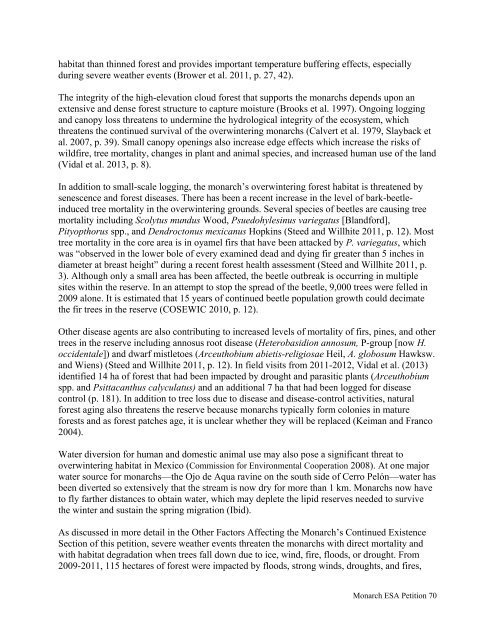monarch-esa-petition-final_61585
monarch-esa-petition-final_61585
monarch-esa-petition-final_61585
Create successful ePaper yourself
Turn your PDF publications into a flip-book with our unique Google optimized e-Paper software.
habitat than thinned forest and provides important temperature buffering effects, especially<br />
during severe weather events (Brower et al. 2011, p. 27, 42).<br />
The integrity of the high-elevation cloud forest that supports the <strong>monarch</strong>s depends upon an<br />
extensive and dense forest structure to capture moisture (Brooks et al. 1997). Ongoing logging<br />
and canopy loss threatens to undermine the hydrological integrity of the ecosystem, which<br />
threatens the continued survival of the overwintering <strong>monarch</strong>s (Calvert et al. 1979, Slayback et<br />
al. 2007, p. 39). Small canopy openings also increase edge effects which increase the risks of<br />
wildfire, tree mortality, changes in plant and animal species, and increased human use of the land<br />
(Vidal et al. 2013, p. 8).<br />
In addition to small-scale logging, the <strong>monarch</strong>’s overwintering forest habitat is threatened by<br />
senescence and forest diseases. There has been a recent increase in the level of bark-beetleinduced<br />
tree mortality in the overwintering grounds. Several species of beetles are causing tree<br />
mortality including Scolytus mundus Wood, Psuedohylesinus variegatus [Blandford],<br />
Pityopthorus spp., and Dendroctonus mexicanus Hopkins (Steed and Willhite 2011, p. 12). Most<br />
tree mortality in the core area is in oyamel firs that have been attacked by P. variegatus, which<br />
was “observed in the lower bole of every examined dead and dying fir greater than 5 inches in<br />
diameter at breast height” during a recent forest health assessment (Steed and Willhite 2011, p.<br />
3). Although only a small area has been affected, the beetle outbreak is occurring in multiple<br />
sites within the reserve. In an attempt to stop the spread of the beetle, 9,000 trees were felled in<br />
2009 alone. It is estimated that 15 years of continued beetle population growth could decimate<br />
the fir trees in the reserve (COSEWIC 2010, p. 12).<br />
Other disease agents are also contributing to increased levels of mortality of firs, pines, and other<br />
trees in the reserve including annosus root disease (Heterobasidion annosum, P-group [now H.<br />
occidentale]) and dwarf mistletoes (Arceuthobium abietis-religiosae Heil, A. globosum Hawksw.<br />
and Wiens) (Steed and Willhite 2011, p. 12). In field visits from 2011-2012, Vidal et al. (2013)<br />
identified 14 ha of forest that had been impacted by drought and parasitic plants (Arceuthobium<br />
spp. and Psittacanthus calyculatus) and an additional 7 ha that had been logged for disease<br />
control (p. 181). In addition to tree loss due to disease and disease-control activities, natural<br />
forest aging also threatens the reserve because <strong>monarch</strong>s typically form colonies in mature<br />
forests and as forest patches age, it is unclear whether they will be replaced (Keiman and Franco<br />
2004).<br />
Water diversion for human and domestic animal use may also pose a significant threat to<br />
overwintering habitat in Mexico (Commission for Environmental Cooperation 2008). At one major<br />
water source for <strong>monarch</strong>s—the Ojo de Aqua ravine on the south side of Cerro Pelόn—water has<br />
been diverted so extensively that the stream is now dry for more than 1 km. Monarchs now have<br />
to fly farther distances to obtain water, which may deplete the lipid reserves needed to survive<br />
the winter and sustain the spring migration (Ibid).<br />
As discussed in more detail in the Other Factors Affecting the Monarch’s Continued Existence<br />
Section of this <strong>petition</strong>, severe weather events threaten the <strong>monarch</strong>s with direct mortality and<br />
with habitat degradation when trees fall down due to ice, wind, fire, floods, or drought. From<br />
2009-2011, 115 hectares of forest were impacted by floods, strong winds, droughts, and fires,<br />
Monarch ESA Petition 70




